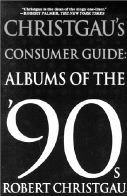FOR THIS FLEDGLING music junkie trolling for a fix in the late ’70s, Creem magazine was an oasis in a sea of teenybopper rags. In particular, one writer there had me reading and rereading his columns and reviews. I eventually tracked his work to its point of origin, The Village Voice. Years later, I interviewed this writer for my own magazine; later still, he asked me to write an article for the Voice, a kind gesture that led to my perhaps foolhardy decision to become a freelance writer. All of which I say not just to indemnify myself, but also to help explain the profound effect Robert Christgau’s work has had on readers and writers alike.
Christgau’s Consumer Guide: Albums of the ’90s
by Robert Christgau (Griffin, $19.95)
When Christgau began writing in the ’60s, most popular music coverage consisted of glorified press releases masquerading as journalism, exclamation point-littered liner notes, or teen mags swooning over the latest heartthrob. By contrast, Christgau was cheeky and in-your-face, with a unique gift for concision—all within, as fellow critic John Rockwell put it, “the maze-like construction of his sentences.” This was the work of an English major who loved to play with language, unashamed of his erudite nature. His style also made his work seem like an academic exercise—indeed, he terms himself “the Dean of American Rock Critics.”
Nowhere does Christgau’s professorial nature come out more clearly than in the “Consumer Guide,” the column he has written since 1969, which consists of 100- to 200-word capsule reviews punctuated by letter grades ranging from A-plus to E-minus, a system widely imitated in other publications, e.g. Entertainment Weekly. Though Christgau regularly writes lengthier pieces for the Voice and elsewhere, he’s best known for the Guide, thanks to books collecting his ’70s and ’80s reviews.
The new Christgau’s Consumer Guide: Albums of the ’90s reflects the change of heart the critic had about his work after 20 years of nonstop writing. Realizing that comprehensiveness was becoming impossible with tens of thousands of new releases annually, Christgau decided to pull back and consolidate. Streamlining freed him to focus on the releases he really liked, while designating lesser albums into Honorable Mentions (good records reviewed with one-liners), Choice Cuts (good tracks on stinky records), Turkeys (stinky records, period), and Neither (neither good nor bad enough).
Even if you’ve followed Christgau’s column for a while, his system can be pretty confusing. Practically a whole world unto itself, he spends several paragraphs in the introduction explaining it. The system also lends Albums of the ’90s a problematic structure. While it’s fascinating to track the trajectory of artists’ careers over the years, reading a full review followed by a turkey followed by a short honorable mention followed by a full review can be disorienting. Obviously, no one has enough time to justify trying to fully write up some 4,000 records from the last decade. But you almost wish Christgau had come up with a system that was less convoluted and flowed better—perhaps organizing his favorite albums in the order they appear on the yearly A-lists in the book’s appendix, followed by the categories in alphabetical order by year.
STILL, THE BOOK provides provocative, highly entertaining reading, even when Christgau’s prose grows as convoluted as his grading system. “I intend . . . my one-liners to be informative, entertaining, and, uh-oh, original,” he states in the introduction. “Uh-oh” is right: Since the Guide is written for the Voice, Christgau aims his writing at an audience that is, like himself, a specific kind of New York bohemian, possessing plenty of attitude and, to some outsiders, a kind of highfalutin air. He assumes his readership already is very knowledgeable and conversant about music, and he tends to leave out facts while artfully pegging details. Take this thumbnail review of Peter Scherer’s Very Neon Pet: “Fourth World Vol. V: Possible Technopangaea.” Unless you’re already familiar with the Jon Hassell and Miles Davis albums it alludes to, chances are his review will lose you—even if, like me, you have a BA in English and a quarter-century of music fanaticism under your belt.
But I’ll be damned if I’m not entertained and informed by what I do pick up on. Christgau obviously enjoys the act of writing; even reviews of records he hates are highly readable. And his work is strewn with all manner of clever, humorous literary devices, from lyrical nods (on M.O.T.: “Sold their Chevy to the Levys but the Levys can’t drive”) to clever wordplay (on Chuck D: “If rap . . . is the black CNN, the coiner of that historic phrase has gone public access”) to artful contrasts (on Meg Hentges: “Straight rock by gay women”).
The sheer bulk and breadth of what’s covered is astounding, moving from vaudeville legend Al Jolson to Moroccan shamen the Master Musicians of Joujouka to ’60s holdovers like Mick Jagger and Paul McCartney and managing to say something interesting about all of them. Even for the “outsiders,” who actually make up the majority of the music audience, Christgau’s whole aesthetic is on display here to see: a scholarly writer who looks for the big picture and does so with lyrical flair and more than a smidgen of humor. Roll over Alan Watts, and tell William Carlos Williams the news.




